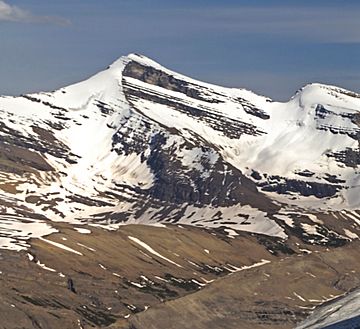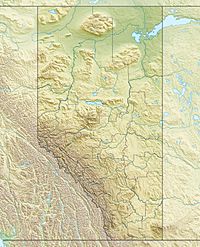Lynx Mountain facts for kids
Quick facts for kids Lynx Mountain |
|
|---|---|
 |
|
| Highest point | |
| Elevation | 3,192 m (10,472 ft) |
| Prominence | 425 m (1,394 ft) |
| Geography | |
| Location | Alberta-British Columbia |
| Parent range | Rainbow Range |
| Topo map | NTS 83E/03 |
| Climbing | |
| First ascent | 1913 ACC Party, W. Schauffelberger |
Lynx Mountain is a cool mountain peak found in the Canadian Rockies. It stands tall right on the continental divide, which is like a natural border. This means it's located between the provinces of Alberta and British Columbia in Canada. It's part of a group of mountains called the Cushina Ridge, within the larger Continental Ranges.
The mountain got its name from an interesting discovery. In 1908, an explorer named Lucius Quincy Coleman found the remains of a lynx (a type of wild cat) on the ice of the nearby Coleman Glacier. That's how Lynx Mountain got its unique name!
Contents
Discover Lynx Mountain: A Peak in the Rockies
Lynx Mountain is a significant peak in the Canadian Rockies. It's known for its location on the continental divide. This divide separates the water that flows to the Pacific Ocean from the water that flows to the Atlantic Ocean.
How Tall is Lynx Mountain?
This impressive mountain reaches a height of 3,192 meters (about 10,472 feet) above sea level. That's pretty tall! It's one of the many high peaks in this famous mountain range.
Where Can You Find Lynx Mountain?
Lynx Mountain is special because it's located within two important protected areas. Part of the mountain is in Mount Robson Provincial Park in British Columbia. The other part is in Jasper National Park in Alberta. These parks are famous for their amazing natural beauty and wildlife.
The Lynx Formation: A Geological Connection
The mountain also has a connection to geology, which is the study of Earth's rocks and how they are formed. A specific layer of rock, known as the Lynx Formation, was named after Lynx Mountain. This happened in 1913, and it was named by a scientist named Charles Doolittle Walcott. This rock layer is part of the Western Canadian Sedimentary Basin, a huge area where many layers of rock have been laid down over millions of years.


